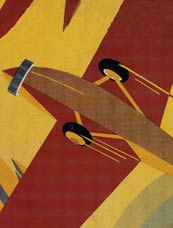|
LOCKHEED VEGA Model 5B NC926Y
LITHUANIA OR BUST (AND IT DID)
This airplane is a Lockheed Vega Model 5B (S/N 134; ATC
#227) manufactured during 1930 by Lockheed Aircraft Corporation,
Burbank,
CA. It left the factory with a Pratt & Whitney
Wasp engine (S/N 2100) of 450 HP. It was a five-place
airplane.
It was sold during 1930 to Shell Oil Company, San Francisco,
CA. While owned by Shell between 1930 and 1935 it was
flown by the Company’s aviation manager Capt. John
Macready. It was painted orange-yellow with red trim
and named "No. 4".
We find NC926Y landing at Tucson on June 2, 1931, flown
by Macready. He
was carrying four unidentified passengers southbound from
Phoenix, AZ to Douglas, AZ. There is nothing in the
NASM record or the Register that suggests the purpose of
the flight.
Below, courtesy of the City of Vancouver, Canada Archives, is a photograph dated July 22, 1931, about six weeks after its visit at Tucson. Pilot Macready stands at center with a ribbon pinned to his left lapel (unreadable with magnification). The photo caption from the link states, "Shell Oil Plane at Airport Opening [showing] Premier Tolmie, Mayor Taylor, Pilot McCleary [sic]."
Simon Frasier Tolmie, on the right, was Premier of Vancouver Province. The airport is unidentified in the caption, but it is the Sea Island facility in Vancouver, B.C., Canada. Mayor Taylor, at left, was L.D. Taylor, who, "As Mayor, L.D.’s contributions included the construction of the Sea Island Airport...." Years earlier, in 1896, Taylor had been arrested for embezzlement in the U.S. He fled north to Canada, settling in Vancouver, where he became a publisher and politician until his death fifty years later in 1946. The truck in the right background says, "Imperial Aviaxxxx."
Lockheed NC926Y, July 22, 1931 (Source: Tim Kalina via Link)
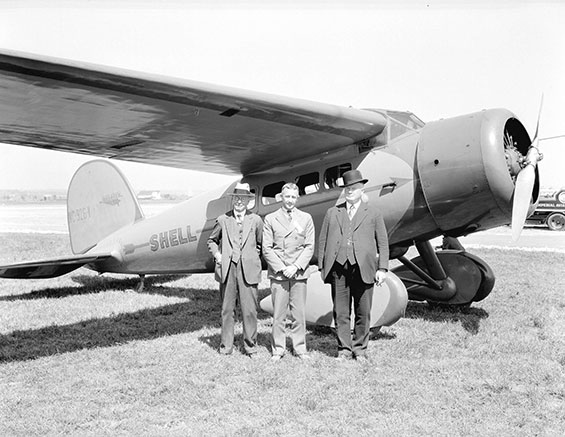 |
Below is a postcard photograph of the Vancouver Airport, ca. 1931. Note the white border between the grass and the taxiway behind the airplane in the photograph above and compare it with the white lines in the photograph below. As well, he airplane at top center looks like it might be a Lockheed Vega, perhaps NC926Y. The writing on top of the hangar says "Vancouver B.C."
Vancouver, B.C., Canada Airport, Ca. 1931 (Source: Web)
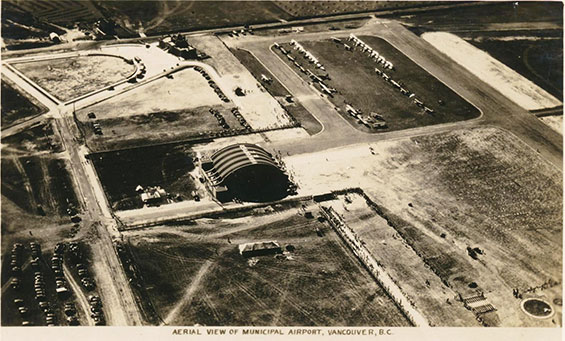 |
Shell sold the airplane during 1935 to the American-Lithuanian
Trans-Atlantic Flight Association, Chicago, IL. It
was planned to use the airplane for a non-stop flight from
New York to Kaunas, Lithuania. A previous attempt was
made in July 1933 using a Bellanca CH Special NR688E (not
signed in our Registers). That
aircraft was named “Lituanica”. The Atlantic
was safely traversed, but the airplane crashed in Germany
and both pilots were killed.
NC926Y was acquired to repeat the attempt and was named “Lituanica
II”. It was licensed NR (image above) and painted
white with orange trim and black edging. Lt. Felix
Waitkus, of Lithuanian descent, was chosen to be the pilot
and the airplane preparation was completed at Kohler, WI. Fuselage
fuel tanks replaced the seats and the windows were blocked
out.
The flight was attempted by Waitkus to Lithuania from New
York on September 21-22, 1935. The airplane suffered
a forced landing at Ballinrobe, County May, Ireland on the
22nd. The right landing gear collapsed and the wing and fuselage
were damaged. Pilot Waitkus was uninjured and completed
the trip to Lithuania in an airliner. See the update of May 28, 2010, below.
The airplane was shipped to and repaired and rebuilt in
Lithuania. It was put in the care of the Lithuanian
Air Corps. It is thought to have been captured and
taken to the USSR when the Lithuanian government was taken
over by Russia in 1940.
During WW2 Waitkus was a test
pilot for Boeing. He is buried in a small cemetery near Sheboygan,
WI.
No further information.
---o0o---
Below are three new images from friend of dmairfield.org Tim
Kalina. The annotation on the back of the first image is
also shown. NC926Y, Shell #4, is on the right. The other Vega on the left, NC657E,
Shell #5, is not logged in any Register.
Lockheed Vega NC926Y
(Source: Kalina)
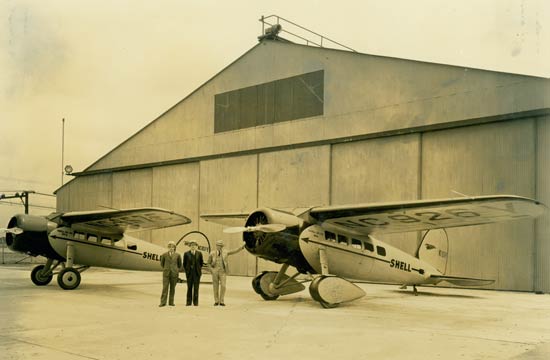 |
The people in the image above are identified on the back
of the photograph, as shown below.
Lockheed Vega NC926Y
(Source: Kalina)
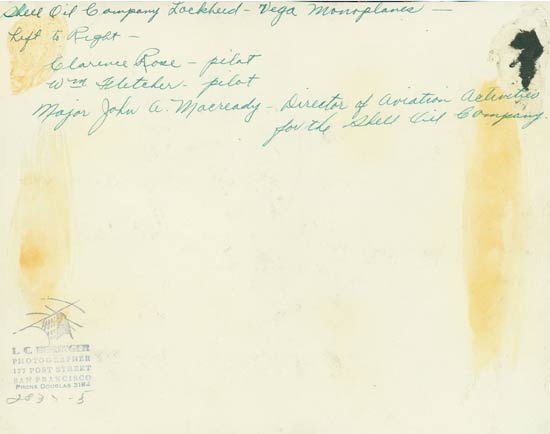 |
Neither Rose nor Fletcher are signed in the Register. This image, below, shows NC926Y, Macready
and his salutation and signature to an unknown recipient
of this handsome souvenir photo card. Compare this photograph with the similar one at Macready's link. Notice the difference between the portraits of Macready, while the image of the airplane remains the same. These souvenirs were probably given to passengers as a memento of their flight. Note also that Macready is identified as a captain in his salutation, but as a major in the photo caption above.
Lockheed Vega NC926Y
(Source: Kalina)
 |
Below, the airplane in its "Lituanica II" livery. This photo was taken at Floyd Bennett Field, LI, NY in September 1935 just before the trans-Atlantic flight attempt cited above. Compare this image with the one above. For some reason while at Floyd Bennett, the Shell aviation fuel logo (seen on the forward fuselage in the photo of the airplane above) was removed. Perhaps there was a change of sponsor.
The dolly under the tail skid has four fully castering wheels. Was the dolly used to ease ground handling in tight spaces, or as an aid to reduce friction of the tail skid during takeoff by the heavily fuel-laden airplane? While it probably helped with the former, it was the latter that it was designed for. There is a photograph of the airplane taking off with the dolly in place and the little wheels tracking along nicely. Pilot Waitkus must have really had his right foot in the bucket to keep the airplane in a straight line.
Lockheed NR926Y at Floyd Bennett Field, 1935
(Source: Kalina)
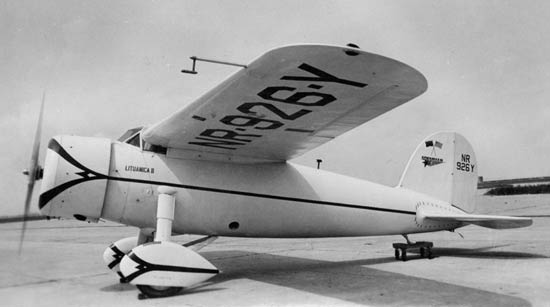 |
Thanks to Tim for sharing these images with us!
---o0o---
Below are six images shared with us by the Howard family (cited, right sidebar). We presently know little about the people. All the photos were taken at Boeing field in Seattle in the early 30's. If you can identify any of the people, please let us KNOW.
Below, ten men stand in front of a hangar with the Shell Oil logo on the side of the small kiosk. The individual on the far right wears helmet and goggles, but does not appear to be Macready or either of the other pilots, Rose or Fletcher, seen in the photo above. The small building is a fueling station. This was a large hangar and there were three fueling stations distributed along the front of it.
Ten Men In Front of Hangar, Date & Location Unknown (Source: Howard)
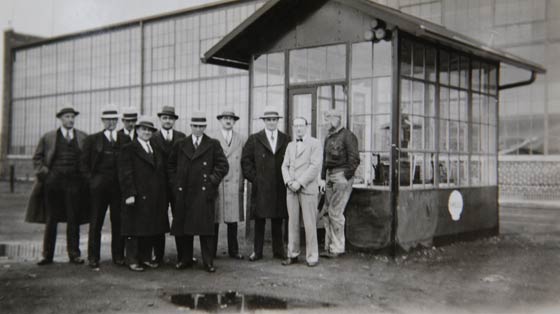 |
Below, one man in front of the Vega. He appears to be the same person as the one 4th from right in the photo above. From the similarity in dress and the sogginess of the day, these photos may have been taken together. This would suggest the people in these and the following images are VIPs, given that a lot of film was exposed in their honor.
Individual In Front of NC926Y, Date & Location Unknown (Source: Howard)
 |
Below, one man in front of the Vega. His leather coat is different than the one worn by the individual in helmet and goggles in the top image. He probably is not Macready (hairline is different from the vignette portrait, above), but it is hard to tell because the photograph is slightly blurred.
Individual In Front of NC926Y, Date & Location Unknown (Source: Howard)
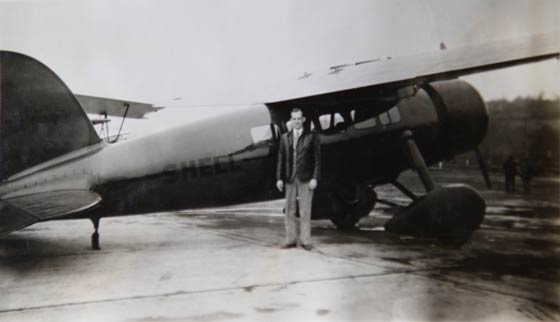 |
Below, five men in front of the Vega. They can also be identified among the group of ten, above.
Five Men In Front of NC926Y, Date & Location Unknown (Source: Howard)
 |
Below, the same five men, having been given instructions to smile. The two smoke stacks in the background at right are a dead give away that the location is Boeing Field, Seattle.
Five Men In Front of NC926Y, Date & Location Unknown (Source: Howard)
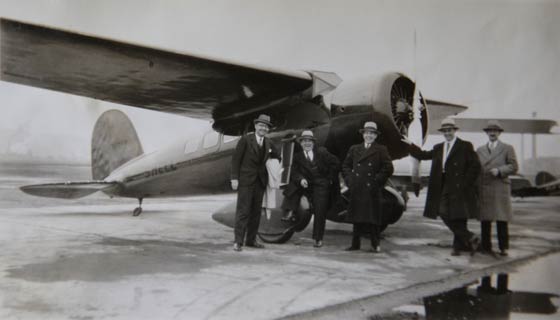 |
Below, the same five men, hats off.
Five Men In Front of NC926Y, Date & Location Unknown (Source: Howard)
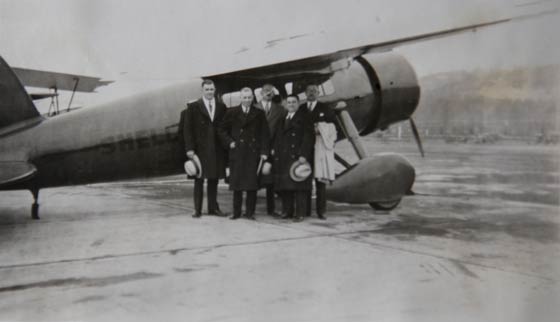 |
One cite visitor states about the photo just above, "... believe that is Beacon Hill in the background. Capitol Hill is further north, near downtown Seattle, with First Hill in between. Smokestacks [at right in the second photo above] appear to be the old power plant located at the north end of Boeing Field, in Georgetown in south Seattle. There is still a similar facility there to this day."
Thanks to the Howard family for sharing these images with us!
---o0o---
UPDATE OF 05/28/10 The images below are from the camera of eye witnesses to the crash of NR926Y, "Lituanica II," in Ireland on September 22, 1935. They are shared with us by Patsy Murphy, whose father took the photographs. First, a photo of the aircraft as is sat on the ground at Ballinrobe.
NR926Y on the Ground in Ballinrobe, September 22, 1935 (Source: Murphy)
 |
Below, a closer view of the port front quarter. The damage to the right landing gear and wingtip was extensive.
NR926Y, Front, Port Quarter, Ballinrobe, September 22, 1935 (Source: Murphy)
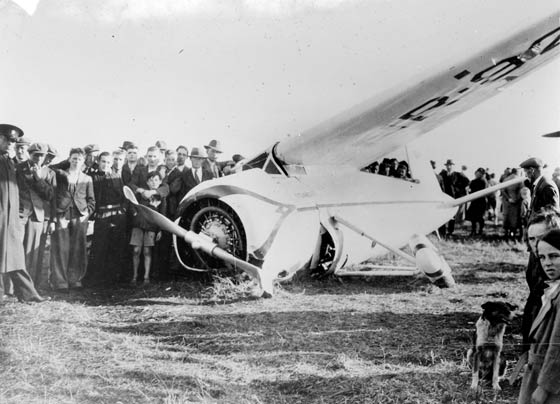 |
The next photograph is described by Mr. Murphy as, "... a group of local people from Ballinrobe who were attracted to the landing site just about a mile outside of town on the Sunday afternoon. The plane had landed at 10AM that morning. My mother who died last year at 100 years was one of the group half hidden."
Group Under Wing of NR926Y, Ballinrobe, September 22, 1935 (Source: Murphy)
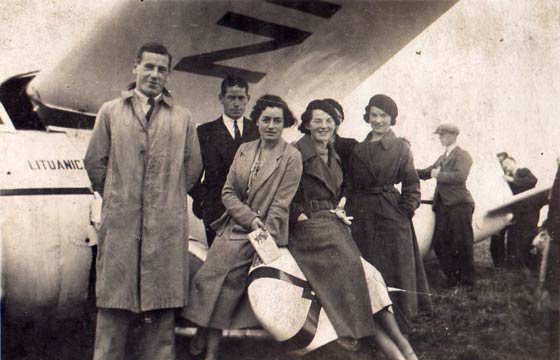 |
Below, Mr. Murphy's describes this as, "... a photo of my father standing beside the plane with a young boy (no relation). This photo was probably taken by my mother. You will see the camera case hanging from my father's shoulder." You can see better the extensive damage to the right landing gear. The dark stripe on top of the wing is no doubt painted International Orange for visibility and safety. The stripe would show up nicely against the white.
Mr. Murphy's Father and Unidentified Boy, NR926Y, Ballinrobe, September 22, 1935 (Source: Murphy)
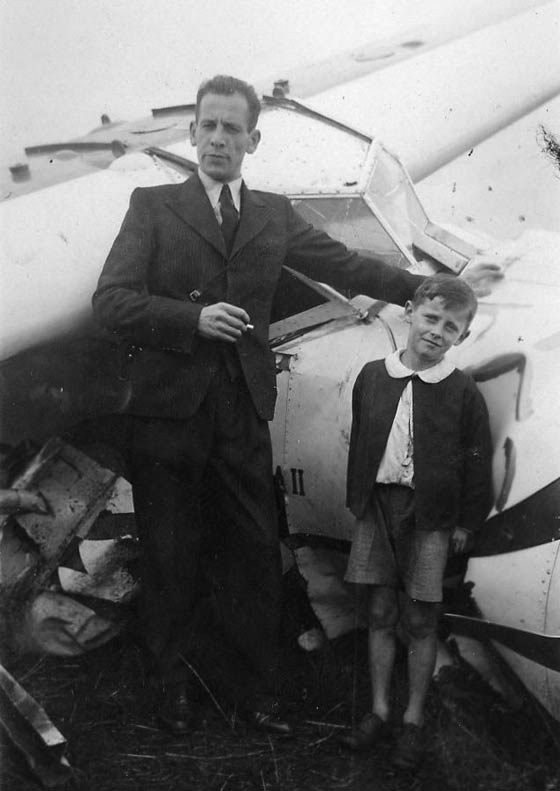 |
Finally, below, Mr. Murphy says this photograph is of, "... the pilot Felix Waitkus talking with a crowd and maybe signing autographs."
Felix Waitkus, Ballinrobe, September 22, 1935 (Source: Murphy)
 |
---o0o---
UPDATE OF 06/08/10 Tim Kalina provides this link to a color video of NR926Y. He says about the film, "The plane appears at 6:56 into the film. This footage would most likely have been taken in Lithuania after the plane was rebuilt following the crash in Ireland." Note the white fuselage and orange stripes.
---o0o---
UPDATE OF 06/10/10 Patsy Murphy sends us this copy from the local County Mayo newspaper of September 28, 1935. Note mention of Register pilot Lady Mary Heath.
County Mayo Newspaper, September 28, 1935 (Source: Murphy)
 |
The inked addition at the bottom captures the last sentence that was cut off the bottom of the column.
Mr. Murphy provides further interest with the images below. Two of the images show the approximate colors of the airplane. Mr. Murphy describes the image below as, "... a piece of the plane with the pilot's signature and date (Sunday 22th September) just about visible on it. This is in the possession of a friend who was only 9 years at the time and spoke to the pilot. He also had a packet of chewing gum up to a few years ago,which Felix gave to him." Note the three-ply structure of the aircraft-grade mahogany plywood.
Wood Piece From the Wrecked "Lithuania II", September 22, 1935 (Source: Murphy)
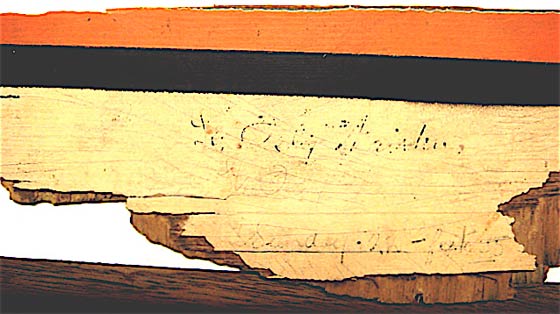 |
Tim Kalina remarks on these samples, "These two pieces confirm my educated guess that the orange trim on the plane was a bright orange and not the much more reddish 'International Orange' or a darker brownish orange as is sometimes cited. It appears from these two pieces that the orange was Berryloid 'Galatea Orange'. Berryloid was a line of aircraft dope produced by Berry Bros. Paints of Detroit [refer to Register pilot Thomas Berry Colby]. Berryloid was the premier aircraft paint in the 1920s and 1930s and was the standard paint used by Lockheed at the time."
Below, another artifact from the airplane which is a 10" piece of fabric, trimmed (pinked) and attached to a display board. Mr. Murphy describes the image as, "... another piece of the plane which turned up a few years ago with a lady who read the story in the Mayo news and contacted me."
Fabric Piece From the Wrecked "Lithuania II", September 22, 1935 (Source: Murphy)
 |
Mr. Murphy says further about this piece, "... It is the same size roughly as the first piece (not sure what part of the plane any of the two pieces are) and I have included a picture of the back as well with a description of the flight." The back is below.
Fabric Piece From the Wrecked "Lithuania II", Caption, September 22, 1935 (Source: Murphy)
 |
Tim Kalina comments on the positions from which the pieces came, "Judging by what appear to be a series of laminations I would say the first section of wood (the smaller one with the autograph) is from the right side of the forward fuselage (beneath the cockpit) and most likely a section of the orange fuselage stripe (which was outlined in black). The larger section, which came from the woman you mentioned, appears to have come from the right wing. It is either a section of one of the wing registration numbers from the lower surface of the wing or a section of the large orange panel on the top of the wing (with the white being a section of the registration number)."
Below, held by a group of school children, Mr. Murphy describes as, "... a piece we believe of the engine cover at the front of the plane. This apparently was stripped off at some stage during the assessment of the damage done to the plane. This is in the possession of a local farmer who lives near the site. He plans to hand over to the National Museum of Ireland."
Part of Engine Cowling, NR926Y (Source: Murphy)
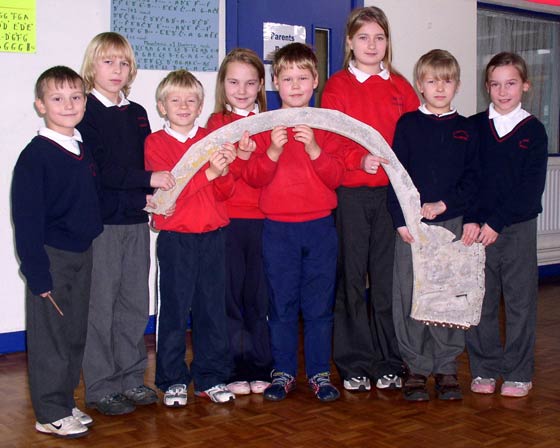 |
Mr. Kalina says about this piece that it is," ... from the port side of the front edge of the engine cowling." He further shares the image below with the location of the artifact outlined in red. The date, location and people are unidentified.
NC926Y, Location of Cowling Artifact (Source: Kalina)
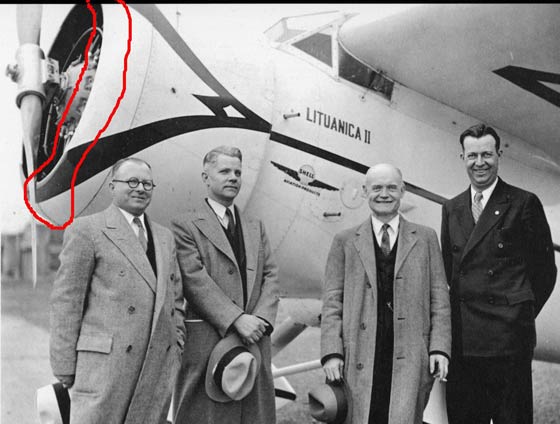 |
Mr. Murphy also shares this link to Lithuanian TV coverage of the dedication of a monument and celebration of the landing in Ireland. Mr. Murphy is interviewed at about 13:45 into the coverage. He talks about his father's photographs and his research into the flight of "Lithuanica II." This link goes to the Ballinrobe/Lithuania Web site, which exhibits a news film of the airplane and pilot Waitkus on the ground at Ballinrobe.
---o0o---
THIS PAGE UPLOADED: 06/06/06 REVISED: 08/20/06, 09/28/07, 02/27/08, 01/06/10, 05/28/10, 06/08/10, 06/10/10, 11/01/14
|

